In week 6, we had learned about pollination and development of plant embryo. We were able to compare the development of animal and plant, explained the reproduction organ of plants and dicsuss zygotic and somatic embryogenesis. Dr. Parameswari had brought us two conical flasks containing the tissue culture plants. I was really excited to see the plant tissue culture becaue I had never seen these before in my real life. Dr. Parameswari tell us about her experience doing the tissue culture experiment.

Experiment of plant tissue culture
I had learned about the plants reproductive organ. I had learned this before during my matriculation session ad also during my high school. So this topic is quite similar for me. Dr. Parameswari explained us about the plants' reproductive organ which consist of anther, filament, stigma, style ovary, petal, ovule and sepal. Female reproductive organ of plants is stigma, style and ovary which is called as carpel. Male reproductive organ consists of anther and filament which is called as stamen.

Plants' reproductive organ
After that, Dr. Parameswari had a quiz test on the subtopic we had learned. We required to answer it together in the class. After the quiz, I understand the topic directly because at that time, we tried to answer the question without referring the notes. Then, Dr.Parameswari explained us detail about the life cycle of angiosperm (flowering plants). She also show us the video about plants' reproductive organ so we can surely understand because we can imagined the structure in our mind. For me, the plants' reproductive organ is quite tough because we had never seen the process but during this lecture, i can imagine and understand what had Dr. Parameswari teach us because she always tells us to do the scl activity together in groups.

Life cycle of angiosperms (Flowering Plants)
Next, we also had discussed about double fertilization of plants. Pollination is the transfer of pollen to the part of a seed plant containing the ovules. Pollen eliminates the need for a film of water and can be dispersed great distances by air or animals. The other pollinating agent are winds, insects, animal and human. Then, if pollen germinates, it give rise to pollen tube that discharges two sperm into the female gametophyte within the ovule. One sperm nucleus fertilizes the egg, generating a 2N diploid zygote. Another sperm nucleus fertilizes a polar cell with two 1N nuclei, generating a 3N triploid endosperm which provides nutrients to the developing embryo. It was really amazing learn about the double fertilization of plants. It such a unique creation in life.

After that, Dr. Parameswari had a quiz test on the subtopic we had learned. We required to answer it together in the class. After the quiz, I understand the topic directly because at that time, we tried to answer the question without referring the notes. Then, Dr.Parameswari explained us detail about the life cycle of angiosperm (flowering plants). She also show us the video about plants' reproductive organ so we can surely understand because we can imagined the structure in our mind. For me, the plants' reproductive organ is quite tough because we had never seen the process but during this lecture, i can imagine and understand what had Dr. Parameswari teach us because she always tells us to do the scl activity together in groups.

Life cycle of angiosperms (Flowering Plants)
Next, we also had discussed about double fertilization of plants. Pollination is the transfer of pollen to the part of a seed plant containing the ovules. Pollen eliminates the need for a film of water and can be dispersed great distances by air or animals. The other pollinating agent are winds, insects, animal and human. Then, if pollen germinates, it give rise to pollen tube that discharges two sperm into the female gametophyte within the ovule. One sperm nucleus fertilizes the egg, generating a 2N diploid zygote. Another sperm nucleus fertilizes a polar cell with two 1N nuclei, generating a 3N triploid endosperm which provides nutrients to the developing embryo. It was really amazing learn about the double fertilization of plants. It such a unique creation in life.

. Double fertilization
Furthermore, we also had discussed about the zygotic embryogenesis and somatic embryogenesis. Plant embrogenesis is the process that produces a plant embryo from a fertilised ovule by assyetric cell division and the differentiation of undifferentiated cells into tissues and organs. it occures during sedd development. When the single-celled zygote undergoes a programmed pattern of cell division resulting in a mature embryo. Somatic embryos are formed from plant cells that are not normally involved the development of embryos and no endosperm or seed coat is formed around a somatic embryo.

Zygotic embyogenesis
Furthermore, we also had discussed about the zygotic embryogenesis and somatic embryogenesis. Plant embrogenesis is the process that produces a plant embryo from a fertilised ovule by assyetric cell division and the differentiation of undifferentiated cells into tissues and organs. it occures during sedd development. When the single-celled zygote undergoes a programmed pattern of cell division resulting in a mature embryo. Somatic embryos are formed from plant cells that are not normally involved the development of embryos and no endosperm or seed coat is formed around a somatic embryo.

Zygotic embyogenesis
No comments:
Post a Comment